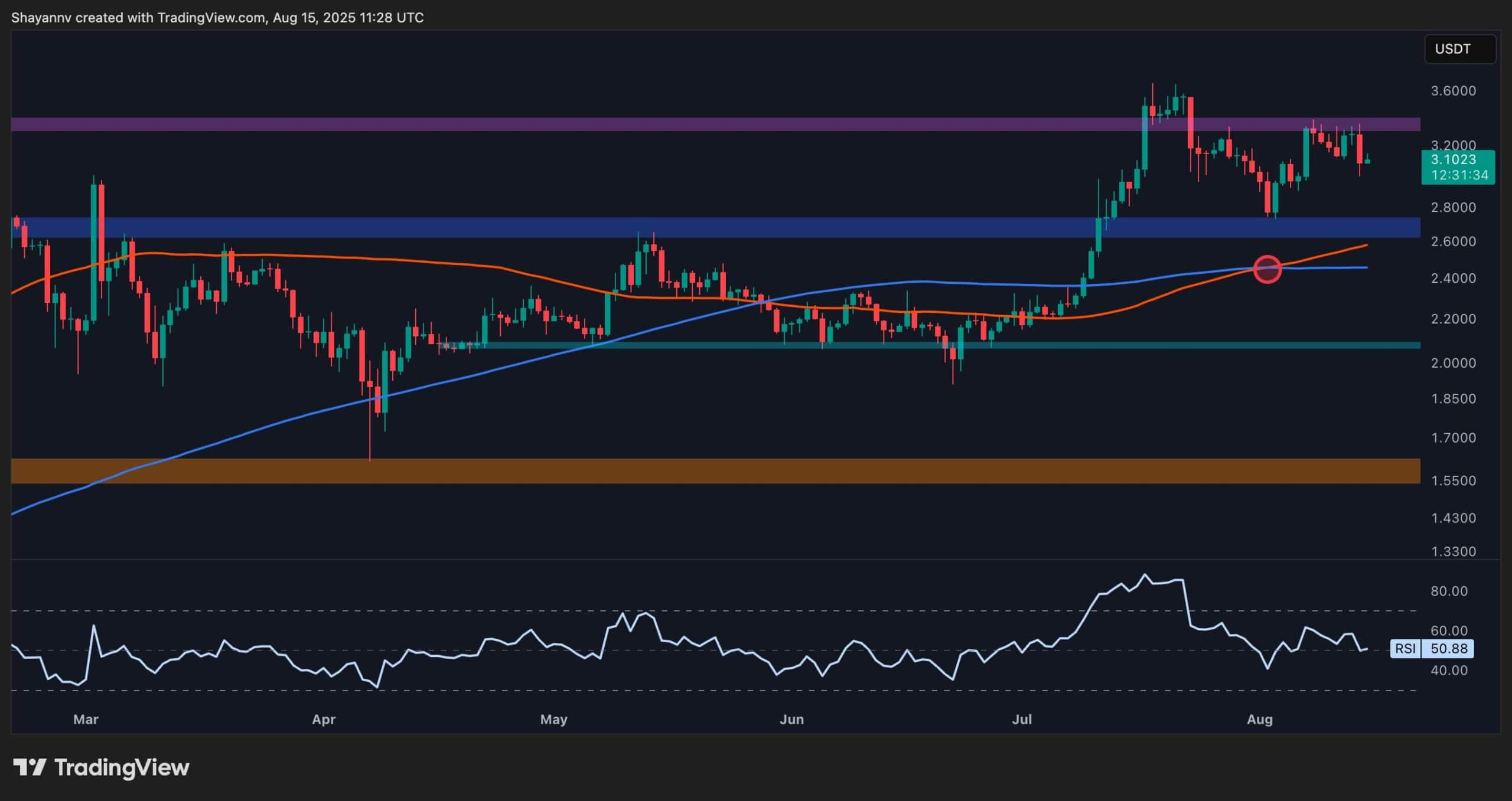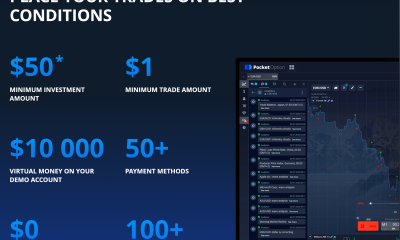Cryptocurrency
Achieving Equilibrium Between Blockchain Security and Decentralization (Op-Ed)

By Trevor Traina, Founder and CEO of Kresus
You are reading these words because our planet is orbiting the sun at just the right distance to neither fry nor freeze us. Our planet is perfectly balanced for life to thrive. And within that world, numerous other forces exist in a state of optimal balance: light and dark, tropical and polar, terrestrial and aquatic.
So it is when it comes to designing blockchain systems. Their most powerful forces must be balanced in such a way that one cannot usurp another. Security should be as high as possible, but this must be balanced with the need to maintain sufficient decentralization. Network fees should be low but not so low as to induce spam attacks.
Finding that Goldilocks zone, the place where conditions are just right, is as much an ideological challenge as it is a technological one. After all, blockchain systems are ultimately designed and used by people who are only as strong as their weakest link. Web3 systems must walk the line between being optimized for security and for decentralization. It’s a delicate balancing act that goes to the very heart of what makes blockchain valuable.
Too Much Decentralization Can Kill You
There’s such a thing as too much freedom, which is why societies have laws and moral codes to regulate the worst excesses of human behavior. When it comes to Web3, it’s similarly possible to have too much freedom (i.e., decentralization) in the form of systems that have no recourse for worst-case scenarios:
- A team member loses their multisig key
- A user loses access to their wallet
- Tokens are sent to the wrong address
- A coding error leaves funds locked into a smart contract
- Assets are stolen using an exploit
All of these are “bad things” by Web3 standards, yet they occur every single day. As new users enter the space, the number of victims of phishing attacks, front-end injection, wallet poisoning, and other exploits will continue to rise. Attackers are getting more sophisticated, while each wave of Web3 users remains as vulnerable as the last.
Only recently, scammers used wallet drainers on Google and X ads to steal digital assets worth close to $60 million. Back in July, meanwhile, it was reported that four separate wallet drainers had stolen close to $65M since the start of 2023.
Give a society too much freedom, and a few of its members will rob, assault, and injure, driving at high speeds and engaging in other risky behaviors. Give Web3 users too much decentralization, and a portion will hack, be hacked, lose access to their wallets, and generally screw up.
Real-world freedom is dampened through security: police forces and CCTV. And blockchain freedom (decentralization) is also mitigated through security, which must be set at the right level to protect users from the most common mistakes while retaining the features that make blockchain so powerful:
- Strong transaction finality
- Lack of centralized control
- Support for financial self-sovereignty
Some crypto users want full control over their assets while also maintaining an undo button if they screw up. Others shudder at the thought of non-custodial wallets being “weakened” through provisions such as social login, seedless design, and key shares held by the developer.
Too Much Centralization Can Kill You
Do you know that saying about pleasing some people some of the time but not all of the people all of the time? That. When it comes to securing decentralized systems, it’s hard to create a single product that satisfies every user type. Put in too many safeguards, and hardcore users will abandon you; force new users to record a lose-it-at-your-peril seed phrase, and sooner or later, they’ll come unstuck.
Add too many centralized levers into a supposedly decentralized protocol, and you risk weakening the very foundations that gave it strength. Consider an ERC20 token contract that is upgradable by its creator. On the one hand, this allows the token’s parameters to be updated to reflect a shift in direction. On the other hand, it allows unscrupulous token creators to rug their operators.
As a result of this dichotomy, DeFi developers must strike a delicate balance between providing users with autonomy over their digital assets and making sure they aren’t taken advantage of by scammers seeking their next mark. Crypto wallets need to be more secure, but developers fear overstepping the boundaries of the decentralized wallet they’ve created.
Go for the Low Hanging Fruit
So what’s the solution? Well, for one thing, developers need to implement security features that can solve real threats – not theoretical ones. Less “military-grade encryption,” in other words, and more practical measures to warn users when they’re connecting to a spoofing site or about to send funds to a known phisher.
A lot of this comes down to better UX and more common sense on behalf of developers. For instance, it would be easy to filter all address poisoning attacks in which a user receives a dust transaction from a “lookalike” wallet they’ve recently interacted with. So why’s no one doing it?
Let’s focus on thwarting the most common hacks and scams before we move on to tackling threats from quantum computing and theoretical MiTM attacks. Hackers don’t go for the toughest possible exploit conceivable; they go for the low-hanging fruit, chalking up easy wins where possible. DeFi developers need to follow suit, focusing on fixing the most common ways in which users get rekt.
Security and autonomy don’t have to operate in conflict with one another: with a little thought, it’s possible to have the best of both worlds, combining the power of non-custodial ownership with a web2-level UI that demystifies everything from transaction signing to wallet backup.
Our planet may be perfectly balanced for life to thrive, but the on-chain environment still has some way to go. Still, it took the earth millions of years to create a climate that was hospitable for intelligent life. At just 15 years of age, blockchain has time on its side.
Author bio
Trevor Traina is the Founder and CEO of Kresus, the go-to Web3 SuperApp that combines a crypto wallet and an NFT platform. He is an investor and seasoned entrepreneur who co-founded five companies that were acquired by the likes of Microsoft, MasterCard, and Intuit and served on multiple non-profit boards such as the Fine Arts Museum of San Francisco and the Venetian Heritage, among others. Trevor served as the U.S. Ambassador to Austria from 2018 to 2021.
Binance Free $100 (Exclusive): Use this link to register and receive $100 free and 10% off fees on Binance Futures first month (terms).
Cryptocurrency
Ethereum Foundation, Whales, and Hackers: What’s Driving the ETH Sell-Off?

TL;DR
- Whales, hackers, and the Ethereum Foundation wallets moved over $500M in ETH through large sales and withdrawals.
- Ethereum transfers rose to 4.6M ETH, nearing the monthly high of 5.2M recorded in July.
- Staking inflows hit 247,900 ETH, the highest in a month, locking more supply from trading.
Large Withdrawals and Whale Activity
Ethereum (ETH) has seen heavy movement from major wallets over the past few days. On-chain data from Lookonchain shows a newly created wallet pulled 17,591 ETH, worth $81.62 million, from Kraken in just two hours.
Over three days, two new wallets withdrew a combined 71,025 ETH, valued at $330 million, from the exchange.
One of these wallets, address 0x2A92, has withdrawn 53,434 ETH, worth $242.34 million, in two days. This includes a recent purchase of 30,069 ETH, valued at $138.46 million, during a market drop.
Major ETH Holders Offload Millions Amid Price Rally
In contrast, several separate entities have been disposing of some ETH holdings. A wallet tied to a hacker address 0x17E0 sold 4,958 ETH for $22.13 million at $4,463, securing a profit of $9.75 million. Earlier this year, the same address sold 12,282 ETH at $1,932 and later bought back part of the amount at higher prices.
A different whale sold 20,600 ETH for $96.55 million over the past two days, generating a profit of more than $26 million after holding the position for nine months.
Meanwhile, an Ethereum Foundation-linked wallet, 0xF39d, sold 6,194 ETH worth $28.36 million in the last three days at an average price of $4,578.
Recent sales from the same wallet included an additional 1,100 ETH and 1,695 ETH for over $12.7 million combined.
The #EthereumFoundation-linked wallet(0xF39d) sold another 1,300 $ETH($5.87M) at $4,518 ~11 hours ago.
Over the past 3 days, this wallet has sold a total of 6,194 $ETH($28.36M) at an average price of $4,578.https://t.co/4hfCWymHVG pic.twitter.com/ErUyEY8SJy
— Lookonchain (@lookonchain) August 15, 2025
Network Activity on the Rise
CryptoQuant data shows Ethereum’s total tokens transferred have been climbing since August 9. After ranging between 1 million and 3 million ETH through late July and early August, transfers have risen to 4.6 million ETH, approaching the monthly high of 5.2 million recorded in mid-July. This increase has occurred alongside a price rally from about $3,400 to $4,600.
Interestingly, staking inflows generally stayed between 20,000 and 80,000 ETH per day over the past month. On August 14, inflows jumped to 247,900 ETH, the highest in the period.
At the time, ETH was trading near $4,600. Large staking deposits reduce the amount of ETH available for immediate trading, as staked coins are locked for a set period.
In the meantime, ETH trades at $4,647 with a 24-hour volume of $68.25 billion, down 2% on the day but up 19% over the week.
Binance Free $600 (CryptoPotato Exclusive): Use this link to register a new account and receive $600 exclusive welcome offer on Binance (full details).
LIMITED OFFER for CryptoPotato readers at Bybit: Use this link to register and open a $500 FREE position on any coin!
Cryptocurrency
Massive DOGE Whale Activity Hints at $1 Breakout

TL;DR
- Whales bought two billion DOGE this week, lifting their combined holdings to 27.6 billion coins.
- A single 900M DOGE transfer worth $208M to Binance drew attention to large exchange movements.
- DOGE broke key resistance, with momentum building for a possible push toward the $1 price mark.
Price and Market Moves
Dogecoin (DOGE) traded at $0.23 at press time, slipping 4% over the past day but still showing a 2% gain for the week. Daily turnover came in at about $6.18 billion.
Meanwhile, the broader crypto market saw over $1 billion in liquidations. Hotter-than-expected US Producer Price Index data pushed traders to scale back expectations of a near-term Federal Reserve rate cut. DOGE had roughly 290,500 coins liquidated during the sell-off.
On the two-week chart, analyst Trader Tardigrade notes that DOGE has cleared a downward-sloping resistance line after completing what appears to be a “wave V” in an Elliott Wave sequence. Similar setups in the past, where prolonged declines stayed within falling channels before breaking higher, have been followed by sharp rallies.
$Doge/2-week#Dogecoin is gaining strong momentum to surge above $1 pic.twitter.com/TuSEKr19nv
— Trader Tardigrade (@TATrader_Alan) August 15, 2025
Momentum gauges are also turning up. The Stochastic RSI, which had dropped into oversold territory, is now heading higher. Previous reversals from this zone have coincided with sustained upward moves. The current formation points to a possible run that could carry DOGE past the $1 mark.
Heavy Whale Buying and Large Transfers
As reported by CryptoPotato, blockchain data shows large investors have added two billion DOGE in the past week, spending just under $500 million. That brings their holdings to about 27.6 billion coins, or 18% of the supply. The buying streak has prompted speculation within the community.
Recently, Whale Alert flagged a 900 million DOGE transfer worth about $208 million into Binance. The tracking indicates that it originated from a wallet connected to the exchange, likely as an internal activity. The address involved holds 2.88 billion DOGE, one of the largest balances on the network.
Ali Martinez also reports that transactions above $1 million reached a one-month high, with activity building since early August and peaking as DOGE traded at $0.25.
Whales are back! Dogecoin $DOGE activity at a 1-month high. pic.twitter.com/C83Pv68mCt
— Ali (@ali_charts) August 14, 2025
Sentiment Building
Analyst Gordon described the current setup as “a nice bit of consolidation” before a potential breakout, adding,
“This will be one of the first coins normies FLOCK to & the pump will be MASSIVE.”
With whale accumulation rising, high-value transfers increasing, and a bullish technical pattern in play, DOGE is positioned for a potential push toward $1 if momentum holds.
Binance Free $600 (CryptoPotato Exclusive): Use this link to register a new account and receive $600 exclusive welcome offer on Binance (full details).
LIMITED OFFER for CryptoPotato readers at Bybit: Use this link to register and open a $500 FREE position on any coin!
Cryptocurrency
Ripple Price Analysis: XRP at Risk as Key Support Levels Could Trigger Sharp Drop

XRP has recently entered a consolidation phase after a strong rally earlier this summer, with the price action now hovering around key resistance levels on both its USDT and BTC pairs. Yet, while momentum has slowed, the charts still indicate a generally bullish structure, with multiple key support levels remaining firmly in place.
Technical Analysis
By ShayanMarkets
The USDT Pair
On the XRP/USDT daily chart, the price is currently trading near the $3.10 mark, facing a strong resistance zone around $3.40. This follows a breakout above the $2.70 range in July, which has now flipped into a support area.
Both the 100-day and 200-day moving averages are also trending upward and recently formed a bullish crossover around $2.45, reinforcing the medium-term bullish sentiment. If the $3.40 resistance breaks, a push toward the critical $4.00 range becomes likely.
However, the RSI hovering near the neutral 50 level suggests a lack of strong momentum for now, meaning a short-term pullback into the $2.80 support zone is still possible.
This zone will be key for maintaining the bullish structure. Losing it could open the door for a deeper correction toward the 200-day moving average located around the $2.40 mark. Yet, as long as the price stays above the moving averages, the broader trend remains bullish.
The BTC Pair
Looking at the XRP/BTC chart, the pair has recently pulled back after hitting the 3,000 SAT resistance, with the price currently around 2,600 SAT.
This follows a clean breakout above the long-term descending channel and a successful retest of its upper boundary, which coincided with the 200-day moving average and the 2,400 SAT support zone. This confluence remains a key bullish technical factor, as holding above it could attract renewed buying pressure.
That said, RSI levels around 48 show that momentum has cooled after the sharp July rally, meaning XRP may continue ranging between 2,400 SAT and 3,000 SAT in the near term. A decisive close above 3,000 SAT would likely open the path to the 3,400 SAT zone, while losing 2,400 SAT could shift the bias back toward 2,000 SAT support. For now, the structure still favors the bulls as long as higher lows remain intact.
Binance Free $600 (CryptoPotato Exclusive): Use this link to register a new account and receive $600 exclusive welcome offer on Binance (full details).
LIMITED OFFER for CryptoPotato readers at Bybit: Use this link to register and open a $500 FREE position on any coin!
Disclaimer: Information found on CryptoPotato is those of writers quoted. It does not represent the opinions of CryptoPotato on whether to buy, sell, or hold any investments. You are advised to conduct your own research before making any investment decisions. Use provided information at your own risk. See Disclaimer for more information.
Cryptocurrency charts by TradingView.

 Forex3 years ago
Forex3 years agoForex Today: the dollar is gaining strength amid gloomy sentiment at the start of the Fed’s week

 Forex3 years ago
Forex3 years agoUnbiased review of Pocket Option broker

 Forex3 years ago
Forex3 years agoDollar to pound sterling exchange rate today: Pound plummeted to its lowest since 1985

 Forex3 years ago
Forex3 years agoHow is the Australian dollar doing today?

 Cryptocurrency3 years ago
Cryptocurrency3 years agoWhat happened in the crypto market – current events today

 World3 years ago
World3 years agoWhy are modern video games an art form?

 Commodities3 years ago
Commodities3 years agoCopper continues to fall in price on expectations of lower demand in China

 Economy3 years ago
Economy3 years agoCrude oil tankers double in price due to EU anti-Russian sanctions

























